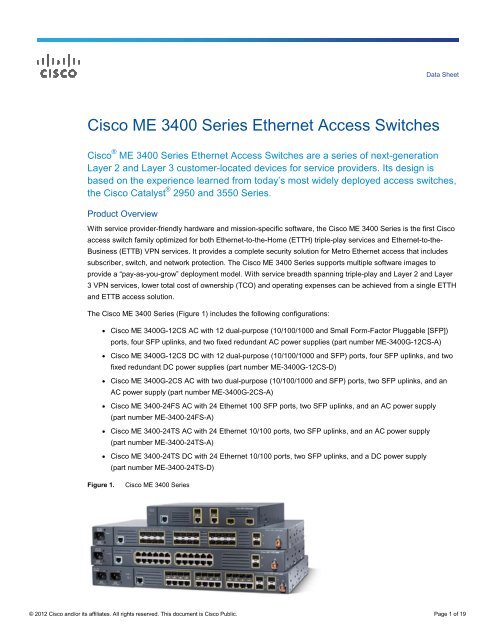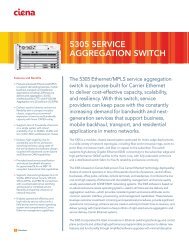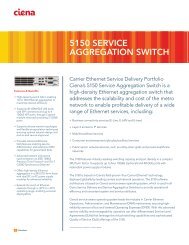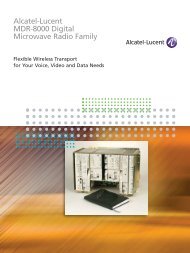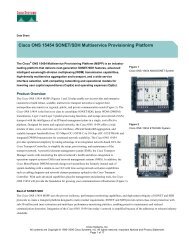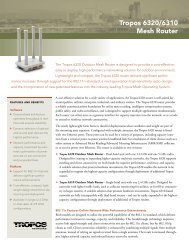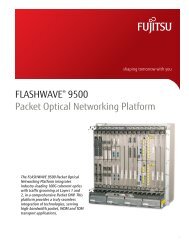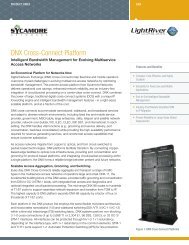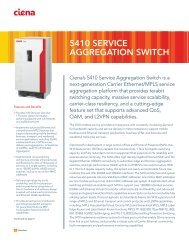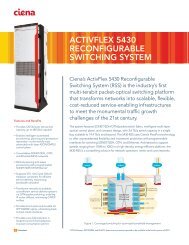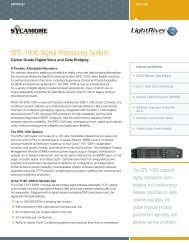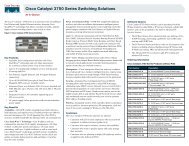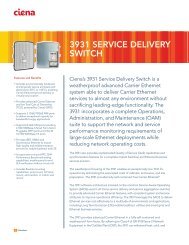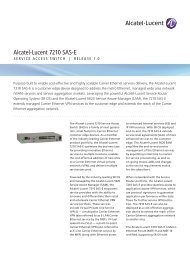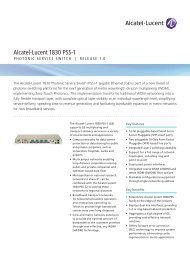Cisco ME 3400 Series Data Sheet - LightRiver Technologies
Cisco ME 3400 Series Data Sheet - LightRiver Technologies
Cisco ME 3400 Series Data Sheet - LightRiver Technologies
Create successful ePaper yourself
Turn your PDF publications into a flip-book with our unique Google optimized e-Paper software.
<strong>Data</strong> <strong>Sheet</strong><br />
<strong>Cisco</strong> <strong>ME</strong> <strong>3400</strong> <strong>Series</strong> Ethernet Access Switches<br />
<strong>Cisco</strong> ® <strong>ME</strong> <strong>3400</strong> <strong>Series</strong> Ethernet Access Switches are a series of next-generation<br />
Layer 2 and Layer 3 customer-located devices for service providers. Its design is<br />
based on the experience learned from today’s most widely deployed access switches,<br />
the <strong>Cisco</strong> Catalyst ® 2950 and 3550 <strong>Series</strong>.<br />
Product Overview<br />
With service provider-friendly hardware and mission-specific software, the <strong>Cisco</strong> <strong>ME</strong> <strong>3400</strong> <strong>Series</strong> is the first <strong>Cisco</strong><br />
access switch family optimized for both Ethernet-to-the-Home (ETTH) triple-play services and Ethernet-to-the-<br />
Business (ETTB) VPN services. It provides a complete security solution for Metro Ethernet access that includes<br />
subscriber, switch, and network protection. The <strong>Cisco</strong> <strong>ME</strong> <strong>3400</strong> <strong>Series</strong> supports multiple software images to<br />
provide a “pay-as-you-grow” deployment model. With service breadth spanning triple-play and Layer 2 and Layer<br />
3 VPN services, lower total cost of ownership (TCO) and operating expenses can be achieved from a single ETTH<br />
and ETTB access solution.<br />
The <strong>Cisco</strong> <strong>ME</strong> <strong>3400</strong> <strong>Series</strong> (Figure 1) includes the following configurations:<br />
● <strong>Cisco</strong> <strong>ME</strong> <strong>3400</strong>G-12CS AC with 12 dual-purpose (10/100/1000 and Small Form-Factor Pluggable [SFP])<br />
ports, four SFP uplinks, and two fixed redundant AC power supplies (part number <strong>ME</strong>-<strong>3400</strong>G-12CS-A)<br />
● <strong>Cisco</strong> <strong>ME</strong> <strong>3400</strong>G-12CS DC with 12 dual-purpose (10/100/1000 and SFP) ports, four SFP uplinks, and two<br />
fixed redundant DC power supplies (part number <strong>ME</strong>-<strong>3400</strong>G-12CS-D)<br />
● <strong>Cisco</strong> <strong>ME</strong> <strong>3400</strong>G-2CS AC with two dual-purpose (10/100/1000 and SFP) ports, two SFP uplinks, and an<br />
AC power supply (part number <strong>ME</strong>-<strong>3400</strong>G-2CS-A)<br />
● <strong>Cisco</strong> <strong>ME</strong> <strong>3400</strong>-24FS AC with 24 Ethernet 100 SFP ports, two SFP uplinks, and an AC power supply<br />
(part number <strong>ME</strong>-<strong>3400</strong>-24FS-A)<br />
● <strong>Cisco</strong> <strong>ME</strong> <strong>3400</strong>-24TS AC with 24 Ethernet 10/100 ports, two SFP uplinks, and an AC power supply<br />
(part number <strong>ME</strong>-<strong>3400</strong>-24TS-A)<br />
● <strong>Cisco</strong> <strong>ME</strong> <strong>3400</strong>-24TS DC with 24 Ethernet 10/100 ports, two SFP uplinks, and a DC power supply<br />
(part number <strong>ME</strong>-<strong>3400</strong>-24TS-D)<br />
Figure 1.<br />
<strong>Cisco</strong> <strong>ME</strong> <strong>3400</strong> <strong>Series</strong><br />
© 2012 <strong>Cisco</strong> and/or its affiliates. All rights reserved. This document is <strong>Cisco</strong> Public. Page 1 of 19
The <strong>Cisco</strong> <strong>ME</strong> <strong>3400</strong> <strong>Series</strong> offers three different <strong>Cisco</strong> IOS ® Software feature images. The <strong>ME</strong>TROBASE image<br />
offers advanced quality of service (QoS), rate limiting, robust multicast control, and comprehensive security<br />
features. The <strong>ME</strong>TROACCESS image adds to these a richer set of Metro Ethernet access features including<br />
802.1Q Tunneling, Layer 2 Protocol Tunneling (L2PT), and Flex-Link. The <strong>ME</strong>TROIPACCESS image adds to<br />
these advanced Layer 3 features such as support for advanced IP routing protocols, Multi-VPN Routing and<br />
Forwarding Customer Edge (Multi-VRF CE), and Policy Based Routing (PBR).<br />
The SFP-based Gigabit Ethernet ports accommodate a wide range of 100BASE and 1000BASE SFP transceivers.<br />
The options include <strong>Cisco</strong> 100BASE-LX, 100BASE-FX, 100BASE-BX, 100BASE-EX, 100BASE-ZX, 1000BASE-T,<br />
1000BASE-SX, 1000BASE-LX, 1000BASE-ZX, 1000BASE-EX, and both coarse wavelength-division multiplexing<br />
(CWDM) and dense wavelength-division multiplexing (DWDM) SFP transceivers. These ports also support the<br />
<strong>Cisco</strong> Catalyst 3560 SFP Interconnect Cable for establishing a low-cost Gigabit Ethernet point-to-point connection.<br />
Service Provider-Friendly Hardware<br />
Because Metro Ethernet access switches are typically deployed in small spaces in the basements of office<br />
buildings or in apartments, the <strong>Cisco</strong> <strong>ME</strong> <strong>3400</strong> <strong>Series</strong> is designed with a compact form factor (1 RU x 9.52 in.) and<br />
flexible mounting options. In addition, the <strong>Cisco</strong> <strong>ME</strong> <strong>3400</strong> <strong>Series</strong> has all front-accessed connectors to simplify field<br />
installation and troubleshooting. To help ensure compliance with industry standards, the <strong>Cisco</strong> <strong>ME</strong> <strong>3400</strong> <strong>Series</strong><br />
has obtained both Network Equipment Building Standards Level 3 (NEBS3) and ETSI certifications.<br />
Industry Standard Services<br />
Carrier Ethernet is a huge growth area for emerging connectivity services. It is a comparatively simple, costeffective,<br />
and familiar technology whose migration to the WAN will lead to more flexible network connectivity while<br />
reducing overall IT costs. To establish better global standards that provide assurance that equipment from<br />
different vendors will interoperate, service providers asked the Metro Ethernet Forum (<strong>ME</strong>F) to initiate a set of<br />
standards and a certification program. The <strong>Cisco</strong> <strong>ME</strong> <strong>3400</strong> <strong>Series</strong> is certified to <strong>ME</strong>F 9 and 14 to support industrystandard<br />
Layer 2 services and QoS features.<br />
Gigabit Ethernet<br />
With more and more applications demanding higher bandwidth, both enterprise and residential customers want<br />
access speeds greater than 100 Mbps. To address this requirement, the <strong>Cisco</strong> <strong>ME</strong> <strong>3400</strong> <strong>Series</strong> offers wire-speed<br />
Gigabit Ethernet with all the Metro Ethernet functions. At speeds of 1000 Mbps, Gigabit Ethernet provides the<br />
bandwidth to meet new and evolving network demands, alleviate bottlenecks, and boost performance while<br />
protecting the investment in existing infrastructure.<br />
Metro-Specific Software<br />
<strong>Cisco</strong> <strong>ME</strong> <strong>3400</strong> <strong>Series</strong> Switches have software designed for the Metro Ethernet market. Numerous new features<br />
make the <strong>Cisco</strong> <strong>ME</strong> <strong>3400</strong> <strong>Series</strong> the optimal access switch for service providers. Many default behaviors of the<br />
<strong>Cisco</strong> <strong>ME</strong> <strong>3400</strong> <strong>Series</strong> are different from those of traditional Ethernet switches, making the <strong>Cisco</strong> <strong>ME</strong> <strong>3400</strong> <strong>Series</strong><br />
easier to configure, manage, secure, and troubleshoot.<br />
UNI/ENI/NNI<br />
The <strong>Cisco</strong> <strong>ME</strong> <strong>3400</strong> <strong>Series</strong> software introduces the concept of User-Network Interface/Enhanced Network<br />
Interface/Network-Node Interface (UNI/ENI/NNI) for Ethernet access switches. Because the software can identify<br />
the application of each port, it can provide many powerful default behaviors. Table 1 lists some of the primary<br />
behaviors and benefits of UNI/ENI/NNI.<br />
© 2012 <strong>Cisco</strong> and/or its affiliates. All rights reserved. This document is <strong>Cisco</strong> Public. Page 2 of 19
Table 1.<br />
UNI/ENI/NNI Default Behaviors<br />
Default Behaviors<br />
UNI/ENI default: Down<br />
UNI/ENI default: No Local Switching<br />
UNI/ENI default: Configurable Control<br />
Plane Security Enabled<br />
NNI default: Up<br />
Benefits<br />
Ports must be activated by the service provider before customers can receive service.<br />
Circuit-like behavior protects customers from each other.<br />
Control-plane packets ingressing from the UNI/ENI are dropped in hardware to protect against<br />
denial of service (DoS) attacks by default. Unlike UNI ports, ENI ports provide service providers the<br />
flexibility to selectively discard or peer with customer’s control plane traffic on a per-port, perprotocol<br />
basis for the following L2 protocols: CDP, LLDP, LACP, PAgP, and STP.<br />
Enables automated configuration of the switch through a Dynamic Host Configuration Protocol<br />
(DHCP) or BOOTP server.<br />
Flexible Deployment Options for Software Features<br />
The <strong>Cisco</strong> <strong>ME</strong> <strong>3400</strong> <strong>Series</strong> offers three different <strong>Cisco</strong> IOS Software feature images—<strong>ME</strong>TROBASE,<br />
<strong>ME</strong>TROACCESS, and <strong>ME</strong>TROIPACCESS—providing cost-effective, pay-as-you-grow upgrade options for service<br />
providers deploying multiple services. The service providers do not have to pay for the features they do not need<br />
today and still have the option in the future to receive those features with a simple software upgrade.<br />
Support for multiple software feature images allows service providers to standardize on the <strong>Cisco</strong> <strong>ME</strong> <strong>3400</strong> <strong>Series</strong>,<br />
save on the operating expense of stocking multiple products, simplify training of support technicians, and alleviate<br />
complications in supporting different products for different services.<br />
Table 2 lists key features in the <strong>Cisco</strong> IOS Software images for the <strong>Cisco</strong> <strong>ME</strong> <strong>3400</strong> <strong>Series</strong>.<br />
Table 2.<br />
Key Features in <strong>Cisco</strong> IOS Software Images for <strong>Cisco</strong> <strong>ME</strong> <strong>3400</strong> <strong>Series</strong><br />
<strong>ME</strong>TROBASE <strong>ME</strong>TROACCESS <strong>ME</strong>TROIPACCESS<br />
UNI/ENI/NNI All <strong>ME</strong>TROBASE features All <strong>ME</strong>TROACCESS features<br />
Internet Group Management Protocol (IGMP)<br />
Filtering and Throttling<br />
802.1Q Tunneling, L2PT Static routing<br />
Multicast VLAN Registration (MVR) Ethernet OAM (802.1ag, 802.3ah, E-LMI) Multi-VRF CE (VRF-lite)<br />
Advanced QoS<br />
Y.1731 Fault Management and Performance<br />
Monitoring (Delay Measurement)<br />
Configurable Control Plane Security Configurable per VLAN MAC Learning RIP versions 1 and 2<br />
Configuration File Security Flex-Link EIGRP, OSPF, and IS-IS<br />
DHCP Snooping Dynamic ARP Inspection, IP Source Guard BGPv4<br />
Private VLAN Per Port Per VLAN Ingress Policing NNI Configurable on All Ports<br />
Configuration Rollback Link-State Tracking Source Specific Multicast<br />
DHCP Based Auto Configuration, Image<br />
Update, and Port-Based Allocation<br />
Resilient Ethernet Protocol (REP)<br />
PBR<br />
Source Specific Multicast Mapping<br />
Configurable Control Plane Queue Assignment Ethernet IP SLA and TWAMP Multicast support for VRF (mVRF-Lite)<br />
MAC address learning and aging notifications Embedded Event Manager VRF-aware Services (ARP, Ping, SNMP,<br />
HSRP, uRPF Syslog, Traceroute, FTP, and<br />
TFTP)<br />
Bidirectional Forwarding Detection (BFD) for<br />
OSPF, IS-IS, BGP, HSRP, and EIGRP<br />
Comprehensive Security Solution<br />
As Metro Ethernet networks expand, it is a challenge to provide the same level of security as other access<br />
technologies. <strong>Cisco</strong> <strong>ME</strong> <strong>3400</strong> <strong>Series</strong> Switches provide a comprehensive security solution for Ethernet access<br />
networks by addressing their security features to each of three areas: subscriber, switch, and network security.<br />
© 2012 <strong>Cisco</strong> and/or its affiliates. All rights reserved. This document is <strong>Cisco</strong> Public. Page 3 of 19
Subscriber security helps create protection among customers. A major concern in using a shared device for<br />
multiple customers is how to prevent customers from affecting each other. The <strong>Cisco</strong> <strong>ME</strong> <strong>3400</strong> <strong>Series</strong> addresses<br />
this concern with several different features. The UNI/NNI feature creates a circuit-like behavior to separate<br />
customers’ traffic from each other. DHCP Snooping, Dynamic ARP Inspection, and IP Source Guard help service<br />
providers identify each customer based on MAC, IP address, and port information to help prevent malicious users<br />
from spoofing fake addresses and launching man-in-the-middle attacks.<br />
Switch security is about protecting the switch itself from attacks. The <strong>Cisco</strong> <strong>ME</strong> <strong>3400</strong> <strong>Series</strong> offers features to protect<br />
CPU and configuration files from attacks. The CPU is a critical component of an Ethernet switch that is responsible for<br />
process-control protocols and routing updates; under DoS attack, the CPU could drop those control packets, resulting<br />
in network outage. Other features such as Configurable Control Plane Security and Storm Control protect the CPU<br />
against malicious attacks. The Port Security feature allows service providers to control the number of MAC addresses<br />
each subscriber is allowed, offering protection against overwhelming the switch memory.<br />
Network security features filter all incoming traffic to help ensure that only valid traffic is allowed through the<br />
switch. <strong>Cisco</strong> <strong>ME</strong> <strong>3400</strong> <strong>Series</strong> Switches have features such as access control lists (ACLs) and IEEE 802.1x<br />
authentication to identify the users and packets that are allowed to transmit traffic through the switch.<br />
Table 3 lists these and other key features of the security solution.<br />
Table 3.<br />
Key Features for Each Area of Comprehensive Security Solution<br />
Subscriber Security Switch Security Network Security<br />
UNI default: No Local Switching Configurable Control Plane Security ACLs<br />
DHCP Snooping and IP Source Guard Storm Control IEEE 802.1x<br />
Dynamic ARP Inspection Port Security UNI default: Port Down<br />
Private VLAN Configurable per VLAN MAC learning Configuration File Security<br />
Service Management Options<br />
The <strong>Cisco</strong> <strong>ME</strong> <strong>3400</strong> <strong>Series</strong> offers a superior command-line interface (CLI) for detailed configuration. In addition,<br />
the switches support <strong>Cisco</strong>Works, the <strong>Cisco</strong> CNS 2100 <strong>Series</strong> Intelligence Engine, the <strong>Cisco</strong> IP Solution Center<br />
(ISC), and Simple Network Management Protocol (SNMP) for networkwide management. Service providers can<br />
integrate the <strong>Cisco</strong> <strong>ME</strong> <strong>3400</strong> <strong>Series</strong> transparently into their operations support systems (OSSs) and enable<br />
improved flow-through provisioning.<br />
The <strong>Cisco</strong> CNS 2100 <strong>Series</strong> network device allows service providers to effectively manage a network of <strong>Cisco</strong> <strong>ME</strong><br />
<strong>3400</strong> <strong>Series</strong> and other <strong>Cisco</strong> IOS Software devices. It is a completely self-contained unit that includes a taskoriented<br />
web GUI, a programmable Extensible Markup Language (XML) interface, configuration template<br />
management, and an embedded repository. Network operators can use the web GUI to quickly turn existing <strong>Cisco</strong><br />
IOS Software CLI configuration files into reusable templates. The <strong>Cisco</strong> CNS 2100 <strong>Series</strong> integrates easily into<br />
existing customer OSSs or business support systems (BSSs); it can provision systems with its external repository<br />
support and the event-based <strong>Cisco</strong> IOS Software XML interface that effectively “workflow-enables” deployment of<br />
<strong>Cisco</strong> devices.<br />
<strong>Cisco</strong> ISC is a family of cost-saving intelligent network management applications that provide automated resource<br />
management and rapid profile-based provisioning capabilities. It helps service providers offering Layer 2 VPN<br />
services with provisioning, planning, and troubleshooting features essential to manage the entire lifecycle.<br />
Management features such as policy-based VPN, management VPN, and QoS provisioning help reduce the cost<br />
of deploying Layer 2 VPN services and help guarantee the accuracy of service deployment.<br />
© 2012 <strong>Cisco</strong> and/or its affiliates. All rights reserved. This document is <strong>Cisco</strong> Public. Page 4 of 19
Service providers can also manage the <strong>Cisco</strong> <strong>ME</strong> <strong>3400</strong> <strong>Series</strong> using SNMP versions 2 and 3. A comprehensive<br />
set of MIBs is provided for service providers to collect traffic information in the <strong>Cisco</strong> <strong>ME</strong> <strong>3400</strong> <strong>Series</strong>.<br />
Ethernet Operations, Administration, Maintenance, and Provisioning<br />
The advent of Ethernet as a metropolitan and wide-area networking technology has accelerated the need for a<br />
new set of operations, administration, maintenance, and provisioning (OAM&P) protocols. Service provider<br />
networks are large and complex with a wide user base, and they often involve different operators that must work<br />
together to provide end-to-end services to enterprise customers. To answer enterprise customer demands, service<br />
providers must reduce the mean time to repair (MTTR) and increase service availability. Ethernet OAM&P features<br />
address these challenges and enable service providers to offer carrier-grade services.<br />
The <strong>Cisco</strong> <strong>ME</strong> <strong>3400</strong> <strong>Series</strong> supports industry-standard OAM&P tools including IEEE 802.1ag Connectivity Fault<br />
Management and Ethernet Local Management Interface (E-LMI) protocol. IEEE 802.1ag tools to monitor and<br />
troubleshoot end-to-end Ethernet networks allow service providers to check connectivity, isolate network issues,<br />
and identify customers affected by network issues. E-LMI protocol, developed by the <strong>ME</strong>F, enables service<br />
providers to automatically configure the customer-edge device to match the subscribed service. This automatic<br />
provisioning not only reduces the effort to set up the service, but also reduces the amount of coordination required<br />
between the service provider and enterprise customer. In addition, the <strong>Cisco</strong> <strong>ME</strong><strong>3400</strong> series supports the IEEE<br />
802.3ah Ethernet in the First Mile standard for monitoring, remote failure indication, loopback, and OAM discovery<br />
on the link between the customer equipment and the service provider network.<br />
Furthermore, the <strong>Cisco</strong> <strong>ME</strong> <strong>3400</strong> <strong>Series</strong> supports the ITU-T standard Y.1731, which provides fault management<br />
and complements the IEEE 802.1ag functionality. In addition, <strong>Cisco</strong> <strong>ME</strong><strong>3400</strong> <strong>Series</strong> also supports Y.1731 Delay<br />
Measurement for performance monitoring.<br />
Resilient Ethernet Protocol<br />
Resilient Ethernet Protocol (REP) is a <strong>Cisco</strong> proprietary protocol that provides an alternative to Spanning Tree<br />
Protocol (STP) to control network loops, handle link failures, and improve convergence time. REP is designed to<br />
meet service providers’ requirement for a fast and predicable reconvergence solution for Layer 2 networks. In<br />
addition, REP also supports VLAN load balancing to provide efficient utilization of redundant links. To interoperate<br />
with devices not supporting REP, the edge no neighbor feature makes it possible to achieve fast convergence of<br />
Carrier Ethernet networks even when the REP ring is terminated into a non REP-capable switch.<br />
Applications<br />
<strong>Cisco</strong> <strong>ME</strong> <strong>3400</strong> <strong>Series</strong> Switches help service providers offer a portfolio of profitable, differentiated services,<br />
including Layer 2 and Layer 3 VPN services and triple-play services in both ETTB and ETTH markets.<br />
Triple-Play Service<br />
Triple-play service is a popular choice for service providers because by combining Internet access, voice, and<br />
video services, they can generate higher average revenue per unit (ARPU). Triple-play service provides additional<br />
value by increasing customer retention. The <strong>Cisco</strong> <strong>ME</strong> <strong>3400</strong> <strong>Series</strong> is optimized for triple-play service and offers<br />
service providers the flexibility to connect subscribers through either CAT5 cable or fiber. By delivering the key<br />
features in the areas of QoS, multicast, and security, the <strong>Cisco</strong> <strong>ME</strong> <strong>3400</strong> <strong>Series</strong> helps service providers deploy<br />
successful triple-play service (Figure 2).<br />
© 2012 <strong>Cisco</strong> and/or its affiliates. All rights reserved. This document is <strong>Cisco</strong> Public. Page 5 of 19
Figure 2.<br />
Triple-Play Service<br />
Intelligent Ethernet Demarcation<br />
As Ethernet circuits replace TDM circuits inside of enterprise wiring closets, a replacement for the demarcation<br />
device is also needed. Service providers have traditionally relied on this type of device to separate the<br />
management responsibility. A demarcation device allows service providers to monitor and troubleshoot circuits all<br />
the way into the customer’s wiring closet. The <strong>Cisco</strong> <strong>ME</strong>-<strong>3400</strong>G-2CS Switch offers the same function for an<br />
Ethernet-based network. With support for industry-standard Ethernet OAM&P features, the <strong>Cisco</strong> <strong>ME</strong>-<strong>3400</strong>G-2CS<br />
allows service providers to monitor and troubleshoot Ethernet circuits remotely. This greatly reduces operating<br />
expense for service providers by reducing the numbers of site visits needed to troubleshoot network problems. In<br />
addition, the <strong>Cisco</strong> <strong>ME</strong>-<strong>3400</strong>G-2CS provides the same intelligent features such as QoS, Ethernet security, and<br />
Multicast as other switches in the <strong>Cisco</strong> <strong>ME</strong> <strong>3400</strong> <strong>Series</strong>.<br />
Layer 2 VPN Service<br />
Layer 2 VPN services allow customers to connect remote offices together through a service provider network<br />
without requiring private connections. The <strong>Cisco</strong> <strong>ME</strong> <strong>3400</strong> <strong>Series</strong> is suited for metro access deployments because<br />
it offers features such as 802.1Q Tunneling and L2PT. The <strong>Cisco</strong> <strong>ME</strong> <strong>3400</strong> <strong>Series</strong> helps service providers offer<br />
Layer 2 VPN services to their enterprise or commercial customers (Figure 3). Typically, these switches are<br />
installed in a office building basement serving multiple customers as customer located equipment (CLE).<br />
© 2012 <strong>Cisco</strong> and/or its affiliates. All rights reserved. This document is <strong>Cisco</strong> Public. Page 6 of 19
Figure 3.<br />
Layer 2 VPN Service<br />
Layer 3 VPN Service<br />
With the popularity of IP technologies, Layer 3 VPN is another popular service that service providers like to offer.<br />
Its benefits include a single control plane over different transport technologies, advanced QoS, and high security.<br />
With the Multi-VRF CE feature, the <strong>Cisco</strong> <strong>ME</strong> <strong>3400</strong> <strong>Series</strong> provides a separate routing-table function for each<br />
customer to help ensure separation of customers’ routing information (Figure 4).<br />
Figure 4.<br />
Layer 3 VPN Service<br />
© 2012 <strong>Cisco</strong> and/or its affiliates. All rights reserved. This document is <strong>Cisco</strong> Public. Page 7 of 19
Key Features and Benefits<br />
Table 4 gives features and benefits of the <strong>Cisco</strong> <strong>ME</strong> <strong>3400</strong> <strong>Series</strong>.<br />
Table 4.<br />
Feature<br />
Features and Benefits<br />
Benefit<br />
Next-generation Ethernet<br />
access switches for Metro<br />
Ethernet market<br />
● All-front access provides ease of deployment and troubleshooting in the field.<br />
● Compact form factor (1 RU x 9.52 in.) allows for deployment in space-limited areas.<br />
● Dual-speed SFP transceivers support (100BASE and 1000BASE) provides flexible uplink options.<br />
● Both AC and DC power options are available.<br />
● Software is optimized for Metro Ethernet access.<br />
● Three software feature images help enable support for breadth of services.<br />
● Software upgrade options allow service providers to purchase only the features needed today while retaining<br />
the option to obtain other features through simple software upgrades.<br />
● Upgrade options reduce operating expense by lowering the supporting cost for different products and by<br />
reducing the number of different products needed for sparing.<br />
● <strong>ME</strong>TROBASE software feature image is designed for triple-play services.<br />
● <strong>ME</strong>TROACCESS software feature image is designed for premium triple-play services or Layer 2 VPN<br />
services.<br />
● <strong>ME</strong>TROIPACCESS software feature image is designed for Layer 3 VPN services.<br />
Service Breadth<br />
Triple-play services<br />
Intelligent Ethernet demarcation<br />
Layer 2 VPN service<br />
Layer 3 VPN service<br />
● Advanced QoS functions provide differentiated class of service treatment to support triple-play service.<br />
● Multicast VLAN Registration (MVR) reduces overall bandwidth requirement for multicast distribution in ringbased<br />
networks.<br />
● Comprehensive security solution protects subscribers, switch, and network at the network edge.<br />
● CAT5 and fiber interfaces offer deployment flexibility.<br />
● Source Specific Multicast (SSM) reduces the need for IP Multicast address management and prevents DoS<br />
attacks against receivers.<br />
● SSM mapping provides a mapping of source to group, which allows listeners to find/connect to multicast<br />
sources dynamically, reducing dependencies on the application.<br />
● Industry standard OAM&P 802.1ag (CFM) feature supports end-to-end network monitoring and<br />
troubleshooting. This reduces operating expense by reducing the site visits needed to troubleshoot network<br />
problems.<br />
● E-LMI enables service providers to automatically configure the customer-edge device to match the subscribed<br />
service.<br />
● Ethernet in the First Mile OAM&P (802.3ah) provides support for monitoring, remote failure indication,<br />
loopback, and OAM discovery on the link between the customer equipment and service provider network.<br />
● Carrier class redundancy features (Flex-link, RSTP, REP) to support both hub-and-spoke and ring networks.<br />
● Standard 802.1Q Tunneling creates a hierarchy of 802.1Q tags, helping service providers use a single VLAN<br />
to support customers who have multiple VLANs while preserving customer VLAN IDs and segregating traffic<br />
from different customers within the service provider infrastructure.<br />
● L2PT allows for transport of the customers’ control protocols, thereby allowing for a true virtual-circuit service<br />
across service providers’ shared infrastructure.<br />
● Multi-VRF CE (VRF-lite) forms virtual packet-forwarding tables by associating one or more Layer 3 interfaces<br />
with each VRF, allowing the creation of multiple Layer 3 VPNs on a single <strong>Cisco</strong> <strong>ME</strong> <strong>3400</strong> <strong>Series</strong> Switch.<br />
Interfaces in a VRF could be either physical, as in an Ethernet port, or logical, as in a VLAN switch virtual<br />
interface (SVI), requiring the <strong>ME</strong>TROIPACCESS feature image.<br />
● IP Multicast support in Multi-VRF CE allows customers to migrate to VRF-lite without affecting application and<br />
services that depend on IP Multicast.<br />
● VRF-aware services (ARP, Ping, SNMP, HSRP, uRPF Syslog, Traceroute, FTP, and TFTP) help in managing<br />
individual VRFs.<br />
● Support for multiple IP routing protocols (RIPv1/v2, EIGRP, OSPF, IS-IS, and BGPv4) offers flexible options<br />
for peering between customers and service providers.<br />
© 2012 <strong>Cisco</strong> and/or its affiliates. All rights reserved. This document is <strong>Cisco</strong> Public. Page 8 of 19
Feature<br />
Benefit<br />
Availability and Scalability<br />
Superior redundancy for fault<br />
backup<br />
High-performance IP routing<br />
● IEEE 802.1w Rapid Spanning Tree Protocol (RSTP) provides rapid spanning-tree convergence independent<br />
of spanning-tree timers and offers the benefit of distributed processing.<br />
● Per-VLAN Rapid Spanning Tree (PVRST+) allows rapid spanning-tree reconvergence on a per-VLAN<br />
spanning-tree basis, without requiring the implementation of spanning-tree instances.<br />
● <strong>Cisco</strong> Hot Standby Router Protocol (HSRP and HSRPv2) is supported to create redundant, fail-safe routing<br />
topologies.<br />
● Unidirectional Link Detection Protocol (UDLD) and Aggressive UDLD allow unidirectional links caused by<br />
incorrect fiber-optic connections or port faults to be detected and disabled on fiber-optic interfaces.<br />
● Flex-Link provides fast failover of ports without overhead of control protocols such as the Spanning Tree<br />
Protocol.<br />
● Switch-port autorecovery (errdisable) automatically attempts to reactivate a link that is disabled because of a<br />
network error.<br />
● Equal-cost routing provides for load balancing and redundancy.<br />
● Bandwidth aggregation up to 800 Mbps through <strong>Cisco</strong> Fast EtherChannel ® technology enhances fault<br />
tolerance and offers greater aggregated bandwidth between switches and to routers and individual servers.<br />
● Link-State Tracking helps accelerate Layer 3 reconvergence by taking UNI down when the associated NNI is<br />
down.<br />
● Resilient Ethernet Protocol (REP) provides fast Layer 2 reconvergence in a ring network and offers an<br />
alternative to Spanning Tree Protocol.<br />
● <strong>Cisco</strong> Express Forwarding hardware routing architecture delivers extremely high-performance IP routing.<br />
● Basic IP Unicast routing protocols (static and RIP versions 1 and 2) are supported for small-network routing<br />
applications.<br />
● Advanced IP Unicast routing protocols (OSPF, EIGRP, IS-IS, and BGPv4) are supported for load balancing<br />
and constructing scalable LANs.<br />
● HSRP provides dynamic load balancing and failover for routed links; up to 32 HSRP links are supported per<br />
unit.<br />
● Inter-VLAN IP routing provides for full Layer 3 routing between two or more VLANs.<br />
● BFD allows rapid detection of path and system failures by using a fast hello mechanism. BFD can provide<br />
failure detection on any kind of path between systems. Routing protocols supported include OSPF, IS-IS,<br />
BGP, HSRP and EIGRP.<br />
● Protocol Independent Multicast (PIM) for IP Multicast routing is supported, including PIM sparse mode (PIM-<br />
SM), PIM dense mode (PIM-DM), and PIM sparse-dense mode. The Metro IP Access image is required.<br />
● IPv6 improves the scalability of IP networks by supporting the growing number of users, applications and<br />
services. The functionalities supported include ACLs, DHCP, routing (Unicast routing, RIP, OSPFv3, static<br />
routes), MLD snooping, stateless autoconfig, default router preference, HTTP/HTTPS.<br />
● <strong>Cisco</strong> recommends 128 switch virtual interfaces (SVIs). A maximum of 1000 are supported (depending on the<br />
number of routes and multicast entries).<br />
Multicast<br />
Efficient multicast distribution<br />
Robust multicast control<br />
● Multicast VLAN Registration provides efficient multicast distribution in ring networks by dedicating a single<br />
VLAN for multicast traffic, thereby removing duplicate multicast traffic in other VLANs.<br />
● PIM-SM provides efficient routing of multicast traffic by establishing distribution trees across WANs.<br />
● Source Specific Multicast (SSM) reduces the need for IP Multicast address management and prevents DoS<br />
attacks against receivers.<br />
● SSM mapping provides a mapping of source to group, which allows listeners to find/connect to multicast<br />
sources dynamically, reducing dependencies on the application.<br />
● Multicast Listener Discovery (MLD) snooping v1 and v2 enables efficient distribution of IPv6 multicast data.<br />
With MLD snooping, IPv6 multicast data is selectively forwarded to a list of ports that want to receive the data,<br />
instead of being flooded to all ports in a VLAN.<br />
● IGMP Snooping helps enable intelligent management of multicast traffic by examining IGMP messages.<br />
● IGMP Fast Leave provides a fast channel-changing capability for IPTV services.<br />
● IGMP filtering provides control of groups each user can access.<br />
● IGMP Throttling controls the maximum number of multicast groups each user can access.<br />
● IGMP Proxy allows users anywhere on a downstream network to join an upstream sourced multicast group.<br />
© 2012 <strong>Cisco</strong> and/or its affiliates. All rights reserved. This document is <strong>Cisco</strong> Public. Page 9 of 19
Feature<br />
Benefit<br />
QoS and Control<br />
Advanced QoS<br />
Advanced traffic control<br />
● The <strong>Cisco</strong> Modular QoS CLI provides a modular and highly extensible framework for deploying QoS, by<br />
standardizing the CLI and semantics for QoS features across all platforms that are supported by <strong>Cisco</strong> IOS<br />
Software.<br />
● Standard 802.1p class of service (CoS) and differentiated services code point (DSCP) field classification are<br />
provided, using marking and reclassification on a per-packet basis by source and destination IP address,<br />
source and destination MAC address, VLAN ID, or Layer 4 TCP/User <strong>Data</strong>gram Protocol (TCP/UDP) port<br />
number.<br />
● <strong>Cisco</strong> control-plane and data-plane QoS ACLs on all ports help ensure proper marking on a per-packet basis.<br />
● Shaped Round Robin (SRR) scheduling helps ensure differential prioritization of packet flows by intelligently<br />
servicing the queues.<br />
● Weighted Tail Drop (WTD) provides per QoS class congestion avoidance at the queues before a<br />
disruption occurs.<br />
● Strict priority queuing helps ensure that the highest-priority packets are serviced ahead of all other traffic.<br />
● Priority queue rate limiting provides optional protection against lower priority queue starvation.<br />
● Configurable control plane queue assignment allows service providers to assign control plane traffic to<br />
specific egress queue.<br />
● Prioritization of control plane traffic enables service providers to set QoS markings globally for CPU-generated<br />
traffic so these protocol packets will receive priority in the network.<br />
● There is no performance penalty for advanced QoS functions.<br />
● Upstream and downstream traffic flows from the end station or the uplink are easily managed using ingress<br />
policing and egress shaping.<br />
● Ingress policing provides bandwidth monitoring in increments as low as 8 kbps.<br />
● Ingress policing is provided based on CoS, VLAN ID, DSCP, and QoS ACLs (IP ACLs or MAC ACLs) which<br />
can include source and destination IP address, source and destination MAC address, Layer 4 TCP/UDP<br />
information, or any combination of these fields.<br />
● Egress Weighted Fair Queuing guarantees the Committed Information Rate (CIR) between traffic flows<br />
and queues.<br />
● Egress shaping for each queue provides smooth traffic control of available bandwidth.<br />
● Egress port rate limiting allows the service provider to control the traffic rate that is transmitted out of the port.<br />
Network Security<br />
Comprehensive security<br />
solutions<br />
Subscriber security<br />
● IEEE 802.1x allows dynamic, port-based security by providing user authentication.<br />
● IEEE 802.1x with VLAN assignment allows a dynamic VLAN assignment for a specific user regardless of<br />
where the user is connected.<br />
● IEEE 802.1x and port security are provided to authenticate the port and manage network access for all MAC<br />
addresses.<br />
● IEEE 802.1x readiness check simplifies deployment by generating a report for end hosts capable of 802.1x.<br />
● 802.1x supplicant helps mitigate security threats in the Carrier Ethernet access network by having the switch<br />
(with a supplicant) securely authenticate itself with an upstream switch.<br />
● An absence of local switching behavior provides security and isolation between UNIs, helping ensure that<br />
users cannot monitor or access other users’ traffic on the same switch.<br />
● DHCP Snooping prevents malicious users from spoofing a DHCP server and sending out bogus addresses.<br />
This feature also prevents numerous other attacks such as Address Resolution Protocol (ARP) poisoning.<br />
● Dynamic ARP Inspection helps ensure user integrity by preventing malicious users from exploiting the<br />
insecure nature of the ARP protocol.<br />
● IP Source Guard prevents a malicious user from spoofing or taking over another user’s IP address by creating<br />
a binding table between client’s IP and MAC address, port, and VLAN.<br />
Switch security<br />
● Control Plane Security prevents DoS attacks on the CPU.<br />
● Configurable control plane security on ENI provides service providers the flexibility to selectively discard or<br />
peer with customer’s control plane traffic on a per-port, per-protocol basis.<br />
● Secure Shell (SSH) Protocol, Kerberos, and SNMPv3 provide network security by encrypting administrator<br />
traffic during Telnet and SNMP sessions. SSH, Kerberos, and the cryptographic version of SNMPv3 require a<br />
special cryptographic software image because of U.S. export restrictions.<br />
● Port security secures the access to an access or trunk port based on MAC address. After a specific<br />
timeframe, the aging feature removes the MAC address from the switch to allow another device to connect to<br />
the same port.<br />
● Multilevel security on the console access prevents unauthorized users from altering the switch configuration.<br />
● TACACS+ and RADIUS authentication facilitate centralized control of the switch and restrict unauthorized<br />
© 2012 <strong>Cisco</strong> and/or its affiliates. All rights reserved. This document is <strong>Cisco</strong> Public. Page 10 of 19
Feature<br />
Benefit<br />
users from altering the configuration.<br />
● Configuration File Security helps ensure that only authenticated users have access to the configuration file.<br />
● MAC address learning and aging notifications allow administrators to keep track of subscriber activities.<br />
Network security<br />
● <strong>Cisco</strong> security VLAN ACLs on all VLANs prevent unauthorized data flows from being bridged within VLANs.<br />
● <strong>Cisco</strong> standard and extended IP security router ACLs define security policies on routed interfaces for controlplane<br />
and data-plane traffic.<br />
● Port-based ACLs for Layer 2 interfaces allow for application of security policies on individual switch ports.<br />
● MAC address notification allows administrators to be notified of users added to or removed from the network.<br />
Network monitoring<br />
● Remote Switched Port Analyzer (RSPAN) allows for remote monitoring of the user interface.<br />
● Bidirectional data support on the Switched Port Analyzer (SPAN) port allows the <strong>Cisco</strong> intrusion detection<br />
system to take action when an intruder is detected.<br />
Manageability<br />
Superior manageability<br />
● The <strong>Cisco</strong> IOS Software CLI provides a common user interface and command set with all <strong>Cisco</strong> routers and<br />
<strong>Cisco</strong> Catalyst desktop switches.<br />
● <strong>Cisco</strong> Service Assurance Agent (SAA) provides service-level management throughout the network.<br />
● IEEE 802.1ag Connectivity Fault Management provides standard support for transport fault management. It<br />
allows for discovery and verification of path for Layer 2 services.<br />
● Ethernet Local Management Interface enables automatic configuration of CPE by CLE to support Metro<br />
Ethernet services.<br />
● IEEE 802.3ah Ethernet in the First Mile provides standard support for monitoring, remote failure indication,<br />
loopback, and OAM discovery on the link between the customer equipment and service provider network.<br />
● ITU-T Y.1731 introduces the support for fault management functions, including alarm indication signal (AIS),<br />
remote defect indication (RDI) and locked signal (LCK) to detect and signal a failure in the service path.<br />
● The <strong>Cisco</strong> <strong>ME</strong> <strong>3400</strong> <strong>Series</strong> supports ITU-T Y.1731 Performance Monitoring function to measure delays in the<br />
network.<br />
● Switching <strong>Data</strong>base Manager templates for Layer 2 and Layer 3 deployment allow administrators to easily<br />
optimize memory allocation to the desired features based on deployment-specific requirements.<br />
● VLAN trunks can be created from any port, using standards-based 802.1Q tagging. Up to 1005 VLANs per<br />
switch and up to 128 spanning-tree instances per switch are supported.<br />
● 4000 VLAN IDs are supported.<br />
● RSPAN allows administrators to remotely monitor ports in a Layer 2 switch network from any other switch in<br />
the same network.<br />
● For enhanced traffic management, monitoring, and analysis, the embedded Remote Monitoring (RMON)<br />
software agent supports four RMON groups (history, statistics, alarms, and events).<br />
● Layer 2 traceroute eases troubleshooting by identifying the physical path that a packet takes from source to<br />
destination.<br />
● All nine RMON groups are supported through a SPAN port, permitting traffic monitoring of a single port, a<br />
group of ports, or the entire stack from a single network analyzer or RMON probe.<br />
● Domain Name System (DNS) provides IP address resolution with user-defined device names.<br />
● Trivial File Transfer Protocol (TFTP) reduces the cost of administering software upgrades by downloading<br />
from a centralized location.<br />
● Network Timing Protocol (NTP) provides an accurate and consistent time stamp to all intranet switches.<br />
● The <strong>Cisco</strong> <strong>ME</strong> <strong>3400</strong> <strong>Series</strong> supports the <strong>Cisco</strong> CNS 2100 <strong>Series</strong> Intelligence Engine and SNMP for<br />
networkwide management.<br />
● <strong>Cisco</strong> ISC applications help reduce administration and management costs by providing automated resource<br />
management and rapid profile-based provisioning capabilities.<br />
● Configuration Rollback helps in error recovery by providing the capability to replace the current running<br />
configuration with any saved <strong>Cisco</strong> IOS Software configuration file.<br />
● Embedded Events Manager (EEM) offers the ability to monitor events and take user-defined action when the<br />
monitored events occur or a threshold is reached.<br />
● Dynamic Host Configuration Protocol (DHCP) based auto configuration and image update simplifies<br />
management of large number of switches by automatically downloading specified configuration and image.<br />
● Dynamic Host Configuration Protocol (DHCP) Port-Based Allocation eases the switch management by<br />
allowing the <strong>Cisco</strong> IOS Software DHCP server to always offer the same IP address to the device connected to<br />
a given switch port. Any new device connecting or old device reconnecting to the port will be allocated the<br />
same IP address.<br />
● Service Diagnostics automates a set of network diagnostic procedures derived from the vast troubleshooting<br />
experiences of <strong>Cisco</strong> network experts. These diagnostic tools help customers increase network uptime,<br />
reduce time to repair and improve service levels.<br />
© 2012 <strong>Cisco</strong> and/or its affiliates. All rights reserved. This document is <strong>Cisco</strong> Public. Page 11 of 19
Feature<br />
<strong>Cisco</strong>Works support<br />
Benefit<br />
● Digital optical monitoring (DOM) support provides a service provider with the capability to perform in-service<br />
transceiver monitoring and troubleshooting operations. DOM threshold functions allow the monitoring of real<br />
time optical parameters on DOM SFPs and the comparison against factory-reset values, generating alarm and<br />
warning thresholds.<br />
● <strong>Cisco</strong>Works network management software provides management capabilities on a per-port and per-switch<br />
basis, providing a common management interface for <strong>Cisco</strong> routers, switches, and hubs.<br />
● SNMP versions 1, 2c, and 3 and Telnet provide comprehensive in-band management, and a CLI-based<br />
management console provides detailed out-of-band management.<br />
● <strong>Cisco</strong> Discovery Protocol versions 1 and 2 help enable automatic switch discovery for a <strong>Cisco</strong>Works network<br />
management station.<br />
● <strong>Cisco</strong>Works 2000 LAN Management Solution is supported.<br />
Product Specifications<br />
Table 5 lists product specifications for <strong>Cisco</strong> <strong>ME</strong> <strong>3400</strong> <strong>Series</strong> Ethernet Access Switches.<br />
Table 5.<br />
Product Specifications<br />
Description<br />
Performance<br />
Connectors and cabling<br />
Indicators<br />
Specification<br />
● Forwarding bandwidth:<br />
<strong>Cisco</strong> ◦<br />
<strong>ME</strong> <strong>3400</strong>G-12CS AC: 32 Gbps<br />
<strong>Cisco</strong> ◦<br />
<strong>ME</strong> <strong>3400</strong>G-12CS DC: 32 Gbps<br />
<strong>Cisco</strong> ◦<br />
<strong>ME</strong> <strong>3400</strong>G-2CS AC: 8.0 Gbps<br />
<strong>Cisco</strong> ◦<br />
<strong>ME</strong> <strong>3400</strong>-24FS AC: 8.8 Gbps<br />
<strong>Cisco</strong> ◦<br />
<strong>ME</strong> <strong>3400</strong>-24TS AC: 8.8 Gbps<br />
<strong>Cisco</strong> ◦<br />
<strong>ME</strong> <strong>3400</strong>-24TS DC: 8.8 Gbps<br />
● Forwarding rate:<br />
<strong>Cisco</strong> ◦<br />
<strong>ME</strong> <strong>3400</strong>G-12CS AC: 26 mpps<br />
<strong>Cisco</strong> ◦<br />
<strong>ME</strong> <strong>3400</strong>G-12CS DC: 26 mpps<br />
<strong>Cisco</strong> ◦<br />
<strong>ME</strong> <strong>3400</strong>G-2CS AC: 6.5 mpps<br />
<strong>Cisco</strong> ◦<br />
<strong>ME</strong> <strong>3400</strong>-24FS AC: 6.5 mpps<br />
<strong>Cisco</strong> ◦<br />
<strong>ME</strong> <strong>3400</strong>-24TS AC: 6.5 mpps<br />
<strong>Cisco</strong> ◦<br />
<strong>ME</strong> <strong>3400</strong>-24TS DC: 6.5 mpps<br />
● 128 -MB DRAM and 32 MB flash memory<br />
● Configurable up to 8000 MAC addresses<br />
● Configurable up to 5000 unicast routes<br />
● Configurable up to 1000 IGMP groups and multicast routes<br />
● Configurable maximum transmission unit (MTU) of up to 9000 bytes, for bridging on Gigabit Ethernet ports,<br />
and up to 1998 bytes for bridging and routing on Fast Ethernet ports<br />
10/100 Ports:<br />
● 10/100BASE-TX ports: RJ-45 connectors, 2-pair Category 5 unshielded twisted pair (UTP) cabling<br />
SFP Ports:<br />
● 1000BASE-T SFP-based ports: RJ-45 connectors, 4-pair Category 5 UTP cabling, 10/100/1000BASE-T<br />
operation in host systems with SGMII interface<br />
● 100BASE-FX and -LX: Duplex LC receptacle fiber connectors (multimode and single mode)<br />
● 100BASE-BX: Single-fiber LC receptacle connector (single-mode fiber)<br />
● 100BASE-EX and –ZX: Single mode fiber, which respectively spans up to 40 kilometers long and 80<br />
kilometers long<br />
● 1000BASE-BX: Single-fiber LC receptacle connector (single-mode fiber)<br />
● 1000BASE-EX: Single Mode Fiber with DOM support<br />
● 1000BASE-SX, -LX/LH, and -ZX and CWDM and DWDM: Duplex LC receptacle fiber connectors (multimode<br />
and single-mode fiber)<br />
● <strong>Cisco</strong> Catalyst 3560 SFP Interconnect Cable<br />
● Management console port: RJ45-to-DB9 cable for PC connections<br />
● Per-port status LEDs: Link integrity, port disabled, and activity indications<br />
● System-status LED<br />
© 2012 <strong>Cisco</strong> and/or its affiliates. All rights reserved. This document is <strong>Cisco</strong> Public. Page 12 of 19
Description<br />
Dimensions (H x W x D)<br />
Weight<br />
Mean time between failure<br />
(MTBF)<br />
Specification<br />
● <strong>Cisco</strong> <strong>ME</strong> <strong>3400</strong>G-12CS AC: 1.73 x 17.5 x 11.0 in. (4.4 x 44.5 x 27.9 cm)<br />
● <strong>Cisco</strong> <strong>ME</strong> <strong>3400</strong>G-12CS DC: 1.73 x 17.5 x 11.0 in. (4.4 x 44.5 x 27.9 cm)<br />
● <strong>Cisco</strong> <strong>ME</strong> <strong>3400</strong>G-2CS AC: 1.73 x 10.6 x 7.1 in. (4.4 x 26.9 x 18.2 cm)<br />
● <strong>Cisco</strong> <strong>ME</strong> <strong>3400</strong>-24FS AC: 1.73 x 17.5 x 9.52 in. (4.4 x 44.5 x 24.2 cm)<br />
● <strong>Cisco</strong> <strong>ME</strong> <strong>3400</strong>-24TS AC: 1.73 x 17.5 x 9.52 in. (4.4 x 44.5 x 24.2 cm)<br />
● <strong>Cisco</strong> <strong>ME</strong> <strong>3400</strong>-24TS DC: 1.73 x 17.5 x 9.52 in. (4.4 x 44.5 x 24.2 cm)<br />
● <strong>Cisco</strong> <strong>ME</strong> <strong>3400</strong>G-12CS AC: 9.3 lb (4.2 kg)<br />
● <strong>Cisco</strong> <strong>ME</strong> <strong>3400</strong>G-12CS DC: 9.0 lb (4.1 kg)<br />
● <strong>Cisco</strong> <strong>ME</strong> <strong>3400</strong>G-2CS AC: 3.5 lb (1.6 kg)<br />
● <strong>Cisco</strong> <strong>ME</strong> <strong>3400</strong>-24FS AC: 7.5 lb (2.9 kg)<br />
● <strong>Cisco</strong> <strong>ME</strong> <strong>3400</strong>-24TS AC: 6.9 lb (2.9 kg)<br />
● <strong>Cisco</strong> <strong>ME</strong> <strong>3400</strong>-24TS DC: 6.9 lb (2.9 kg)<br />
● <strong>Cisco</strong> <strong>ME</strong> <strong>3400</strong>G-12CS AC: 247,563 hours<br />
● <strong>Cisco</strong> <strong>ME</strong> <strong>3400</strong>G-12CS DC: 297,688 hours<br />
● <strong>Cisco</strong> <strong>ME</strong> <strong>3400</strong>G-2CS AC: 486,352 hours<br />
● <strong>Cisco</strong> <strong>ME</strong> <strong>3400</strong>-24FS AC: 396,000 hours<br />
● <strong>Cisco</strong> <strong>ME</strong> <strong>3400</strong>-24TS AC: 391,823 hours<br />
● <strong>Cisco</strong> <strong>ME</strong> <strong>3400</strong>-24TS DC: 492,603 hours<br />
Power Specifications<br />
Table 6 gives power specifications for the <strong>Cisco</strong> <strong>ME</strong> <strong>3400</strong> <strong>Series</strong>.<br />
Table 6.<br />
Description<br />
Power Specifications<br />
Specification<br />
Power consumption<br />
AC input voltage and<br />
frequency<br />
● <strong>Cisco</strong> <strong>ME</strong> <strong>3400</strong>G-12CS AC: 65W (typical), 80W (maximum), 273 Btus per hour<br />
● <strong>Cisco</strong> <strong>ME</strong> <strong>3400</strong>G-12CS DC: 55W (typical), 70W (maximum), 239 Btus per hour<br />
● <strong>Cisco</strong> <strong>ME</strong> <strong>3400</strong>G-2CS AC: 15W (typical), 20W (maximum), 68 Btus per hour<br />
● <strong>Cisco</strong> <strong>ME</strong> <strong>3400</strong>-24FS AC: 50W (typical), 70W (maximum), 170 Btus per hour (typical), 240 Btus per hour<br />
(maximum)<br />
● <strong>Cisco</strong> <strong>ME</strong> <strong>3400</strong>-24TS AC: 25W (typical), 30W (maximum), 102 Btus per hour<br />
● <strong>Cisco</strong> <strong>ME</strong> <strong>3400</strong>-24TS DC: 25W (typical), 30W (maximum), 102 Btus per hour<br />
● <strong>Cisco</strong> <strong>ME</strong> <strong>3400</strong>G-12CS AC: 100 to 240 VAC, 1.6 to 0.8A, 50 to 60 Hz<br />
● <strong>Cisco</strong> <strong>ME</strong> <strong>3400</strong>G-2CS AC: 100 to 240 VAC, 0.5 to 0.25A, 50 to 60 Hz<br />
● <strong>Cisco</strong> <strong>ME</strong> <strong>3400</strong>-24FS AC: 100 to 240 VAC, 0.7 to 0.3A, 50 to 60 Hz<br />
● <strong>Cisco</strong> <strong>ME</strong> <strong>3400</strong>-24TS AC: 100 to 240 VAC, 1.0 to 0.5A, 50 to 60 Hz<br />
DC input voltages ● <strong>Cisco</strong> <strong>ME</strong> <strong>3400</strong>G-12CS DC: –36 to –72 VCD, 4.5 to 2.0A<br />
● <strong>Cisco</strong> <strong>ME</strong> <strong>3400</strong>-24TS DC: –36 to –72 VDC, 2.0 to 1.0A<br />
© 2012 <strong>Cisco</strong> and/or its affiliates. All rights reserved. This document is <strong>Cisco</strong> Public. Page 13 of 19
Management and Standards<br />
Table 7 provides management and standards support information for the <strong>Cisco</strong> <strong>ME</strong> <strong>3400</strong> <strong>Series</strong>.<br />
Table 7.<br />
Description<br />
Management<br />
Management and Standards<br />
Specification<br />
● BRIDGE-MIB (RFC1493)<br />
● BGP4-MIB (RFC1657)<br />
● CISCO-CABLE-DIAG-MIB<br />
● CISCO-BULK-FILE-MIB<br />
● CISCO-CDP-MIB<br />
● CISCO-CONFIG-COPY-MIB<br />
● CISCO-CONF-MAN-MIB<br />
● CISCO-DATA-COLLECTION-MIB<br />
● CISCO-ENVMON-MIB<br />
● CISCO-ENTITY-SENSOR-MIB<br />
● CISCO-ERR-DISABLE-MIB<br />
● CISCO-ETHERNET-ACCESS-MIB<br />
● CISCO-FLASH-MIB<br />
● CISCO-FTP-CLIENT-MIB<br />
● CISCO-HSRP-MIB<br />
● CISCO-HSRP-EXT-MIB<br />
● CISCO-IETF-DOT3-OAM-MIB<br />
● CISCO-IGMP-FILTER-MIB<br />
● CISCO-IPLSA-ETHERNET-MIB<br />
● CISCO-PAGP-MIB<br />
● CISCO-PAE-MIB<br />
● CISCO-PING-MIB<br />
● CISCO-PRIVATE-VLAN-MIB<br />
● CISCO-PROCESS-MIB<br />
● CISCO-PORT-QOS-MIB<br />
● CISCO-PORT-SECURITY-MIB<br />
● CISCO-PORT-STORM-CONTROL-MIB<br />
● CISCO-IMAGE-MIB<br />
● CISCO-LAG-MIB<br />
● CISCO-L2L3-INTERFACE-CONFIG-MIB<br />
● CISCO-MAC-NOTIFICATION-MIB<br />
● CISCO-<strong>ME</strong>MORY-POOL-MIB<br />
● CISCO-RTTMON-MIB<br />
● CISCO-STACK-MIB<br />
● CISCO-STP-EXTENSIONS-MIB<br />
● CISCO-SYSLOG-MIB<br />
● CISCO-TCP-MIB<br />
● CISCO-UDLDP-MIB<br />
● CISCO-VLAN-IFTABLE-RELATIONSHIP-MIB<br />
● CISCO-VLAN-<strong>ME</strong>MBERSHIP-MIB<br />
● ENTITY-MIB (RFC2737)<br />
● ETHERLIKE-MIB<br />
● IEEE8021-PEA-MIB<br />
● IEEE8023-LAG-MIB<br />
● IF-MIB (RFC 1573)<br />
● IGMP-MIB<br />
● IPMROUTE-MIB<br />
● LLDP-MIB<br />
● OLD-CISCO-CHASSIS-MIB<br />
● OLD-CISCO-FLASH-MIB<br />
● OLD-CISCO-INTERFACES-MIB<br />
● OLD-CISCO-IP-MIB<br />
● OLD-CISCO-SYS-MIB<br />
● OLD-CISCO-TCP-MIB<br />
● OLD-CISCO-TS-MIB<br />
● OSPF-MIB (RFC 1253)<br />
● PIM-MIB<br />
● RFC1213-MIB (MIB-II)<br />
● RMON-MIB (RFC 1757)<br />
● RMON2-MIB (RFC 2021)<br />
● SNMP-FRA<strong>ME</strong>WORK-MIB (RFC2571)<br />
● SNMP-MPD-MIB (RFC 2572)<br />
● SNMP-NOTIFICATION-MIB (RFC 2573)<br />
● SNMP-TARGET-MIB (RFC 2573)<br />
● SNMPv2-MIB (RFC 1907)<br />
● SNMP-USM-MIB (SNMP-USER-BASED-SM-MIB)<br />
(RFC2574)<br />
● SNMP-VACM-MIB (SNMP-VIEW-BASED-ACM-<br />
MIB) (RFC2575)<br />
● TCP-MIB (RFC 2012)<br />
● UDP-MIB (RFC 2013)<br />
Standards and protocols ● IEEE 802.1s<br />
● IEEE 802.1w<br />
● CISCO-PORT-QOS-MIB<br />
● IEEE 802.1x<br />
● IEEE 802.3ad<br />
● IEEE 802.3ah<br />
● IEEE 802.1ag<br />
● IEEE 802.3x full duplex on 10BASE-T, 100BASE-TX, and 1000BASE-T ports<br />
● IEEE 802.1D Spanning Tree Protocol<br />
● IEEE 802.1p CoS classification<br />
● IEEE 802.1Q VLAN<br />
● IEEE 802.3 10BASE-T<br />
© 2012 <strong>Cisco</strong> and/or its affiliates. All rights reserved. This document is <strong>Cisco</strong> Public. Page 14 of 19
Description<br />
Specification<br />
● IEEE 802.3u 100BASE-T<br />
● IEEE 802.3ab 1000BASE-T<br />
● IEEE 802.3z 1000BASE-X<br />
● IP routing: Static, RIP versions 1 and 2, EIGRP, OSPF, BGPv4, PIM-SM, and PIM-DM (metro IP access only)<br />
● IPv6: MLD Snooping v1 and v2<br />
● IPv6: RIP, OSPFv3, static routes<br />
Management: SNMP versions 1, 2, and 3<br />
Safety and Compliance<br />
Table 8 gives safety and compliance information for the <strong>Cisco</strong> <strong>ME</strong> <strong>3400</strong> <strong>Series</strong>.<br />
Table 8.<br />
Safety and Compliance<br />
Type<br />
Electromagnetic emissions<br />
compliance<br />
Safety<br />
Standards<br />
● FCC Part 15 Class A<br />
● EN 55022B Class A (CISPR22 Class A)<br />
● EN 55024<br />
● EN 300 386<br />
● GR-1089 CORE Class A<br />
● VCCI Class I<br />
● AS/NZS 3548 Class A or AS/NZS CISPR22 Class A<br />
● MIC<br />
● CE Marking<br />
● UL 60950, Third Edition<br />
● UL to CAN/CSA 22.2 No.60950, Third Edition<br />
● TUV/GS to EN 60950 with Amendment A1-A4 and A11<br />
● CB to IEC 60950 with all country deviations<br />
● NOM to NOM-019-SCFI<br />
● AS/NZS 3260, TS001<br />
● CE Marking<br />
● CLEI Coding<br />
NEBS GR-63-CORE and GR-1089-CORE: Level 3, Type 2<br />
ETSI EN 300 019: Storage Class 1.2, Transportation Class 2.3, In-Use Class 3.2<br />
Noise specifications<br />
Operating environment<br />
● <strong>Cisco</strong> Office Product Specification:<br />
dBA (sound pressure)<br />
bels (sound power)<br />
● EN 300 753<br />
● Temperature: 0 to +50ºC (temperature versus altitude curve follows NEBS specifications)<br />
● Altitude: Up to 13,000 ft (4000 m)<br />
● Relative humidity: 5 to 95% noncondensing<br />
Storage environment ● Temperature: –40 to 70ºC<br />
● Altitude: 15,000 ft (4570 m)<br />
◦ 48<br />
◦ 4.8<br />
© 2012 <strong>Cisco</strong> and/or its affiliates. All rights reserved. This document is <strong>Cisco</strong> Public. Page 15 of 19
Ordering Information<br />
Table 9 lists the ordering information for the <strong>Cisco</strong> <strong>ME</strong> <strong>3400</strong> <strong>Series</strong>. To place an order, visit the <strong>Cisco</strong> Ordering<br />
Home Page at: www.cisco.com/en/US/ordering.<br />
Table 9.<br />
Part Number<br />
Ordering Information<br />
Description<br />
<strong>ME</strong>-<strong>3400</strong>G-12CS-A<br />
<strong>ME</strong>-<strong>3400</strong>G-12CS-D<br />
<strong>ME</strong>-<strong>3400</strong>G-2CS-A<br />
<strong>ME</strong>-<strong>3400</strong>-24FS-A<br />
<strong>ME</strong>-<strong>3400</strong>-24TS-A<br />
<strong>ME</strong>-<strong>3400</strong>-24TS-D<br />
S340XB-12244SE<br />
● 12 dual-purpose (10/100/1000 and SFP) ports<br />
● 4 SFP-based Gigabit Ethernet and 100BASE-X ports<br />
● Dual fixed redundant AC power supplies<br />
● 26-mpps forwarding rate<br />
● 1-RU multilayer switch<br />
● Gigabit Ethernet access switch for the Metro Ethernet market<br />
● 3 <strong>Cisco</strong> IOS Software feature image options (<strong>ME</strong>TROBASE, <strong>ME</strong>TROACCESS, and <strong>ME</strong>TROIPACCESS)<br />
● 12 dual-purpose (10/100/1000 and SFP) ports<br />
● 4 SFP-based Gigabit Ethernet and 100BASE-X ports<br />
● Dual fixed redundant DC power supplies<br />
● 26-mpps forwarding rate<br />
● 1-RU multilayer switch<br />
● Gigabit Ethernet access switch for the Metro Ethernet market<br />
● 3 <strong>Cisco</strong> IOS Software feature image options (<strong>ME</strong>TROBASE, <strong>ME</strong>TROACCESS, and <strong>ME</strong>TROIPACCESS)<br />
● 2 dual-purpose (10/100/1000 and SFP) ports<br />
● 2 SFP-based Gigabit Ethernet and 100BASE-X ports<br />
● AC power supplies<br />
● 6.5-mpps forwarding rate<br />
● 1-RU small form-factor multilayer switch<br />
● Intelligent Ethernet demarcation switch<br />
● 3 <strong>Cisco</strong> IOS Software feature image options (<strong>ME</strong>TROBASE, <strong>ME</strong>TROACCESS, and <strong>ME</strong>TROIPACCESS)<br />
● 24 Ethernet 100 SFP ports<br />
● 2 SFP-based Gigabit Ethernet and 100BASE-X ports<br />
● AC power supplies<br />
● 6.5-mpps forwarding rate<br />
● 1-RU multilayer switch<br />
● Ethernet access switch for low density FTTH deployments<br />
● 3 <strong>Cisco</strong> IOS Software feature image options (<strong>ME</strong>TROBASE, <strong>ME</strong>TROACCESS, and <strong>ME</strong>TROIPACCESS)<br />
● 24 Ethernet 10/100 ports<br />
● 2 SFP-based Gigabit Ethernet and 100BASE-X ports<br />
● AC power supply<br />
● 6.5-mpps forwarding rate<br />
● 1-RU multilayer switch<br />
● Ethernet access switch for the Metro Ethernet market<br />
● 3 <strong>Cisco</strong> IOS Software feature image options (<strong>ME</strong>TROBASE, <strong>ME</strong>TROACCESS, and <strong>ME</strong>TROIPACCESS)<br />
● 24 Ethernet 10/100 ports<br />
● 2 SFP-based Gigabit Ethernet and 100BASE-X ports<br />
● DC power supply<br />
● 6.5-mpps forwarding rate<br />
● 1-RU multilayer switch<br />
● Ethernet access switch for the Metro Ethernet market<br />
● 3 <strong>Cisco</strong> IOS Software feature image options (<strong>ME</strong>TROBASE, <strong>ME</strong>TROACCESS, and <strong>ME</strong>TROIPACCESS)<br />
● <strong>Cisco</strong> <strong>ME</strong> <strong>3400</strong> <strong>Series</strong> <strong>ME</strong>TROBASE software feature image<br />
● Standard Layer 2 feature image targeted for triple-play services<br />
● Advanced QoS: Ingress policing and egress shaping<br />
● Robust multicast: IGMP filtering and throttling, and MVR<br />
● Comprehensive security: UNI/NNI, control plane security, and configuration file security<br />
© 2012 <strong>Cisco</strong> and/or its affiliates. All rights reserved. This document is <strong>Cisco</strong> Public. Page 16 of 19
Part Number<br />
S340XA-12244SE<br />
S340XI-12244SE<br />
CD-<strong>ME</strong><strong>3400</strong>-B2A=<br />
CD-<strong>ME</strong><strong>3400</strong>-B2I=<br />
CD-<strong>ME</strong><strong>3400</strong>-A2I=<br />
RCKMNT-1RU=<br />
RCKMNT-REC-1RU=<br />
RCKMNT-ETSI-1RU=<br />
RCKMNT-19IN-1RU=<br />
RCKMNT-19-CMPCT=<br />
RCKMNT-23IN-1RU=<br />
RCKMNT-23-CMPCT=<br />
GLC-LH-SM=<br />
GLC-LH-SMD<br />
GLC-SX-MM=<br />
GLC-SX-MMD<br />
GLC-ZX-SM=<br />
GLC-T=<br />
GLC-BX-D=<br />
GLC-BX-U=<br />
GLC-EX-SMD=<br />
GLC-FE-100FX=<br />
GLC-FE-100LX=<br />
GLC-FE-100BX-U=<br />
GLC-FE-100BX-D=<br />
GLE-GE-100FX=<br />
GLC-FE-100FX24<br />
GLC-FE-100FX48<br />
GLC-FE-100LX48<br />
GLC-FE-100BX-D48<br />
GLC-FE-100EX=<br />
GLC-FE-100ZX=<br />
SFP-GE-S=<br />
SFP-GE-L=<br />
CWDM-SFP-1470=<br />
CWDM-SFP-1490=<br />
Description<br />
● <strong>Cisco</strong> <strong>ME</strong> <strong>3400</strong> <strong>Series</strong> <strong>ME</strong>TROACCESS software feature image<br />
● Enhanced Layer 2 feature images targeted for premium triple-play services and Layer 2 VPN services<br />
● Advanced Layer 2 Tunneling: 802.1q tunneling and L2PT<br />
● Industry-standard Layer 2 management: 802.1ag (CFM) and E-LMI<br />
● Fast convergence: Flex-Link, Link-state Tracking, Resilient Ethernet Protocol<br />
● <strong>Cisco</strong> <strong>ME</strong> <strong>3400</strong> <strong>Series</strong> <strong>ME</strong>TROIPACCESS software feature image<br />
● Layer 3 feature images targeted for Layer 3 VPN services<br />
● IP routing (RIP versions 1 and 2, EIGRP, OSFP, IS-IS, and BGPv4)<br />
● Secured Layer 3: Multi-VRF CE<br />
● Enhanced routing: Policy Based Routing<br />
<strong>ME</strong>TROACCESS image upgrade kit for <strong>Cisco</strong> <strong>ME</strong> <strong>3400</strong> <strong>Series</strong> Switches with <strong>ME</strong>TROBASE image<br />
<strong>ME</strong>TROIPACCESS image upgrade kit for <strong>Cisco</strong> <strong>ME</strong> <strong>3400</strong> <strong>Series</strong> Switches with <strong>ME</strong>TROBASE image<br />
<strong>ME</strong>TROIPACCESS image upgrade kit for <strong>Cisco</strong> <strong>ME</strong> <strong>3400</strong> <strong>Series</strong> Switches with <strong>ME</strong>TROACCESS image<br />
Spare rack-mount kit for the <strong>Cisco</strong> <strong>ME</strong>-<strong>3400</strong>-24FS, <strong>ME</strong>-<strong>3400</strong>-24TS, Catalyst 3750-24TS, Catalyst 3750-48TS,<br />
and Catalyst 3750G-24T<br />
1-RU recessed rack-mount kit for the <strong>Cisco</strong> <strong>ME</strong>-<strong>3400</strong>24FS, <strong>ME</strong>-<strong>3400</strong>-24TS, Catalyst 2970, Catalyst 3550, and<br />
Catalyst 3750<br />
ETSI rack-mount kit for <strong>Cisco</strong> <strong>ME</strong> <strong>3400</strong> <strong>Series</strong> products<br />
19-in. NEBS rack-mount kit for all the <strong>Cisco</strong> <strong>ME</strong><strong>3400</strong> <strong>Series</strong> products, except the <strong>Cisco</strong> <strong>ME</strong> <strong>3400</strong>G-2CS<br />
19-in. NEBS rack-mount kit for the <strong>Cisco</strong> <strong>ME</strong> <strong>3400</strong>G-2CS<br />
23-in. NEBS rack-mount kit for <strong>Cisco</strong> <strong>ME</strong> <strong>Series</strong> products<br />
23-in. NEBS rack-mount kit for the <strong>Cisco</strong> <strong>ME</strong> <strong>3400</strong>G-2CS<br />
Gigabit Ethernet SFP, LC connector, and LH transceiver<br />
Gigabit Ethernet SFP, LC connector, and LH transceiver<br />
Gigabit Ethernet SFP, LC connector, and SX transceiver<br />
Gigabit Ethernet SFP, LC connector, and SX transceiver<br />
Gigabit Ethernet SFP, LC connector, and ZX transceiver<br />
Gigabit Ethernet SFP, RJ-45 connector, and 10/100/1000BASE-T transceiver<br />
1000BASE-BX10 SFP module for single-strand SMF, 1490-nm TX/1310-nm RX wavelength<br />
1000BASE-BX10 SFP module for single-strand SMF, 1310-nm TX/1490-nm RX wavelength<br />
1000BASE-EX SFP<br />
100BASE-FX SFP for Fast Ethernet port<br />
100BASE-LX SFP for Fast Ethernet port<br />
100BASE-BX10-U SFP<br />
100BASE-BX10-D SFP<br />
100BASE-FX (multimode fiber) (works in “multispeed” Gigabit Ethernet SFP ports of other <strong>Cisco</strong> platforms such<br />
as the <strong>Cisco</strong> Catalyst 3560, Catalyst 3750 (non-metro), and Catalyst 2970 <strong>Series</strong>)<br />
24 units of GLC-FE-100FX<br />
48 units of GLC-FE-100FX<br />
48 units of GLC-FE-100LX<br />
48 units of GLC-FE-100BX-D<br />
100BASE-EX SFP (40Km)<br />
100BASE-ZX SFP (80Km)<br />
1000BASE-SX SFP (DOM)<br />
1000BASE-LX/LH SFP (DOM)<br />
<strong>Cisco</strong> CWDM SFP, 1470 nm; Gigabit Ethernet and 1-/2-GB Fibre Channel (gray)<br />
<strong>Cisco</strong> CWDM SFP, 1490 nm; Gigabit Ethernet and 1-/2-GB Fibre Channel (violet)<br />
© 2012 <strong>Cisco</strong> and/or its affiliates. All rights reserved. This document is <strong>Cisco</strong> Public. Page 17 of 19
Part Number<br />
CWDM-SFP-1510=<br />
CWDM-SFP-1530=<br />
CWDM-SFP-1550=<br />
CWDM-SFP-1570=<br />
CWDM-SFP-1590=<br />
CWDM-SFP-1610=<br />
DWDM-SFP-6061=<br />
DWDM-SFP-6141=<br />
DWDM-SFP-5979=<br />
DWDM-SFP-5898=<br />
DWDM-SFP-5817=<br />
DWDM-SFP-5736=<br />
DWDM-SFP-5655=<br />
DWDM-SFP-5575=<br />
DWDM-SFP-5494=<br />
DWDM-SFP-5413=<br />
DWDM-SFP-5252=<br />
DWDM-SFP-5332=<br />
DWDM-SFP-5172=<br />
DWDM-SFP-5092=<br />
DWDM-SFP-5012=<br />
DWDM-SFP-4931=<br />
DWDM-SFP-4851=<br />
DWDM-SFP-4772=<br />
DWDM-SFP-4692=<br />
DWDM-SFP-4612=<br />
DWDM-SFP-4532=<br />
DWDM-SFP-4453=<br />
DWDM-SFP-4373=<br />
DWDM-SFP-4294=<br />
DWDM-SFP-4214=<br />
DWDM-SFP-4134=<br />
DWDM-SFP-4056=<br />
DWDM-SFP-3977=<br />
DWDM-SFP-3898=<br />
DWDM-SFP-3819=<br />
DWDM-SFP-3739=<br />
DWDM-SFP-3661=<br />
DWDM-SFP-3582=<br />
DWDM-SFP-3504=<br />
DWDM-SFP-3425=<br />
DWDM-SFP-3346=<br />
DWDM-SFP-3268=<br />
DWDM-SFP-3190=<br />
Description<br />
<strong>Cisco</strong> CWDM SFP, 1510 nm; Gigabit Ethernet and 1-/2-GB Fibre Channel (blue)<br />
<strong>Cisco</strong> CWDM SFP, 1530 nm; Gigabit Ethernet and 1-/2-GB Fibre Channel (green)<br />
<strong>Cisco</strong> CWDM SFP, 1550 nm; Gigabit Ethernet and 1-/2-GB Fibre Channel (yellow)<br />
<strong>Cisco</strong> CWDM SFP, 1570 nm; Gigabit Ethernet and 1-/2-GB Fibre Channel (orange)<br />
<strong>Cisco</strong> CWDM SFP, 1590 nm; Gigabit Ethernet and 1-/2-GB Fibre Channel (red)<br />
<strong>Cisco</strong> CWDM SFP, 1610 nm; Gigabit Ethernet and 1-/2-GB Fibre Channel (brown)<br />
<strong>Cisco</strong> DWDM SFP 1560.61 nm SFP (100 GHz ITU grid)<br />
<strong>Cisco</strong> DWDM SFP 1561.42 nm SFP (100 GHz ITU grid)<br />
<strong>Cisco</strong> DWDM SFP 1559.79 nm SFP (100 GHz ITU grid)<br />
<strong>Cisco</strong> DWDM SFP 1558.98 nm SFP (100 GHz ITU grid)<br />
<strong>Cisco</strong> DWDM SFP 1558.17 nm SFP (100 GHz ITU grid)<br />
<strong>Cisco</strong> DWDM SFP 1557.36nm SFP (100 GHz ITU grid)<br />
<strong>Cisco</strong> DWDM SFP 1556.55 nm SFP (100 GHz ITU grid)<br />
<strong>Cisco</strong> DWDM SFP 1555.75 nm SFP (100 GHz ITU grid)<br />
<strong>Cisco</strong> DWDM SFP 1554.94 nm SFP (100 GHz ITU grid)<br />
<strong>Cisco</strong> DWDM SFP 1554.13 nm SFP (100 GHz ITU grid)<br />
<strong>Cisco</strong> DWDM SFP 1552.52 nm SFP (100 GHz ITU grid)<br />
<strong>Cisco</strong> DWDM SFP 1553.33nm SFP (100 GHz ITU grid)<br />
<strong>Cisco</strong> DWDM SFP 1551.72 nm SFP (100 GHz ITU grid)<br />
<strong>Cisco</strong> DWDM SFP 1550.92 nm SFP (100 GHz ITU grid)<br />
<strong>Cisco</strong> DWDM SFP 1550.12 nm SFP (100 GHz ITU grid)<br />
<strong>Cisco</strong> DWDM SFP 1549.32nm SFP (100 GHz ITU grid)<br />
<strong>Cisco</strong> DWDM SFP 1548.51 nm SFP (100 GHz ITU grid)<br />
<strong>Cisco</strong> DWDM SFP 1547.72 nm SFP (100 GHz ITU grid)<br />
<strong>Cisco</strong> DWDM SFP 1546.92 nm SFP (100 GHz ITU grid)<br />
<strong>Cisco</strong> DWDM SFP 1546.12 nm SFP (100 GHz ITU grid)<br />
<strong>Cisco</strong> DWDM SFP 1545.32nm SFP (100 GHz ITU grid)<br />
<strong>Cisco</strong> DWDM SFP 1544.53 nm SFP (100 GHz ITU grid)<br />
<strong>Cisco</strong> DWDM SFP 1543.73 nm SFP (100 GHz ITU grid)<br />
<strong>Cisco</strong> DWDM SFP 1542.94 nm SFP (100 GHz ITU grid)<br />
<strong>Cisco</strong> DWDM SFP 1542.14 nm SFP (100 GHz ITU grid)<br />
<strong>Cisco</strong> DWDM SFP 1541.35nm SFP (100 GHz ITU grid)<br />
<strong>Cisco</strong> DWDM SFP 1540.56 nm SFP (100 GHz ITU grid)<br />
<strong>Cisco</strong> DWDM SFP 1539.77 nm SFP (100 GHz ITU grid)<br />
<strong>Cisco</strong> DWDM SFP 1538.98 nm SFP (100 GHz ITU grid)<br />
<strong>Cisco</strong> DWDM SFP 1538.19 nm SFP (100 GHz ITU grid)<br />
<strong>Cisco</strong> DWDM SFP 1537.40nm SFP (100 GHz ITU grid)<br />
<strong>Cisco</strong> DWDM SFP 1536.61 nm SFP (100 GHz ITU grid)<br />
<strong>Cisco</strong> DWDM SFP 1535.82 nm SFP (100 GHz ITU grid)<br />
<strong>Cisco</strong> DWDM SFP 1535.04 nm SFP (100 GHz ITU grid)<br />
<strong>Cisco</strong> DWDM SFP 1534.25 nm SFP (100 GHz ITU grid)<br />
<strong>Cisco</strong> DWDM SFP 1533.47 nm SFP (100 GHz ITU grid)<br />
<strong>Cisco</strong> DWDM SFP 1532.68 nm SFP (100 GHz ITU grid)<br />
1000BASE-DWDM 1531.90 nm SFP (100 GHz ITU grid)<br />
© 2012 <strong>Cisco</strong> and/or its affiliates. All rights reserved. This document is <strong>Cisco</strong> Public. Page 18 of 19
Part Number<br />
DWDM-SFP-3112=<br />
DWDM-SFP-3033=<br />
CSS5-CABLX-LCSC=<br />
CSS5-CABSX-LC=<br />
CSS5-CABSX-LCSC=<br />
CAB-SFP-50CM=<br />
CAB-SM-LCSC-1M<br />
CAB-SM-LCSC-5M<br />
CAB-MCP-LC=<br />
Description<br />
1000BASE-DWDM 1531.12 nm SFP (100 GHz ITU grid)<br />
<strong>Cisco</strong> DWDM SFP 1530.33 nm SFP (100 GHz ITU grid)<br />
<strong>Cisco</strong> CSS 11500 <strong>Series</strong> Content Services Switch, 10 m single-mode fiber, LX LC-to-SC connectors<br />
<strong>Cisco</strong> CSS 11500 10 m multimode fiber, SX LC connectors<br />
<strong>Cisco</strong> CSS 11500 10 m multimode fiber, SX LC-to-SC connectors<br />
<strong>Cisco</strong> Catalyst 3560 SFP Interconnect Cable (50 cm)<br />
1 m single-mode fiber, LC-to-SC connectors<br />
5 m single-mode fiber, LC-to-SC connectors<br />
Mode-conditioning patch cable; LC connector<br />
Service and Support<br />
<strong>Cisco</strong> offers a wide range of services programs to accelerate customer success. These innovative services programs<br />
are delivered through a unique combination of people, processes, tools, and partners, resulting in high levels of<br />
customer satisfaction. <strong>Cisco</strong> services help you protect your network investment, optimize network operations, and<br />
prepare your network for new applications to extend network intelligence and the power of your business. For more<br />
information about <strong>Cisco</strong> services, refer to <strong>Cisco</strong> Technical Support Services or <strong>Cisco</strong> Advanced Services.<br />
<strong>Cisco</strong> is committed to minimizing your total cost of ownership. <strong>Cisco</strong> offers a portfolio of technical support services<br />
to help ensure that <strong>Cisco</strong> products operate efficiently, remain highly available, and benefit from the most up-todate<br />
system software. The services and support programs described in Table 10 are available as part of the <strong>Cisco</strong><br />
Metro Ethernet Switching Service and Support solution, and are available directly from <strong>Cisco</strong> and through<br />
resellers.<br />
Table 10.<br />
Service and Support<br />
Service and Support Features Benefits<br />
Advanced Services<br />
<strong>Cisco</strong> Total Implementation Solutions<br />
(TIS), available directly from <strong>Cisco</strong><br />
<strong>Cisco</strong> Packaged TIS, available through<br />
resellers<br />
<strong>Cisco</strong> SP Base Support and Service<br />
Provider-Based Onsite Support, available<br />
directly from <strong>Cisco</strong><br />
<strong>Cisco</strong> Packaged Service Provider-Based<br />
Support, available through resellers<br />
● Project management<br />
● Site survey, configuration, and deployment<br />
● Installation, text, and cutover<br />
● Training<br />
● Major moves, adds, and changes<br />
● Design review and product staging<br />
● 24-hour access to software updates<br />
● Web access to technical repositories<br />
● Telephone support through the <strong>Cisco</strong> Technical<br />
Assistance Center (TAC)<br />
● Advance Replacement of hardware parts<br />
● Supplement existing staff<br />
● Help ensure functions meet needs<br />
● Mitigate risk<br />
● Facilitate proactive or expedited<br />
problem resolution<br />
● Lower total cost of ownership by taking<br />
advantage of <strong>Cisco</strong> expertise and knowledge<br />
● Minimize network downtime<br />
Printed in USA C78-424368-09 05/12<br />
© 2012 <strong>Cisco</strong> and/or its affiliates. All rights reserved. This document is <strong>Cisco</strong> Public. Page 19 of 19


